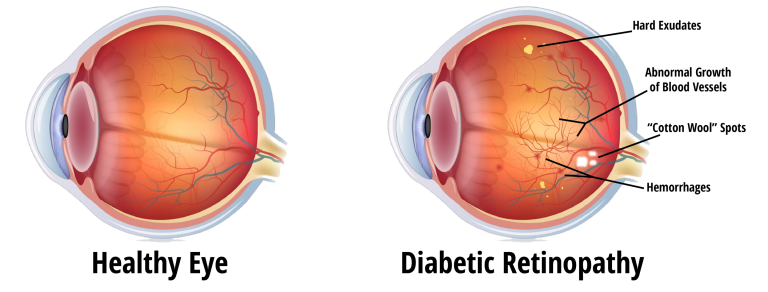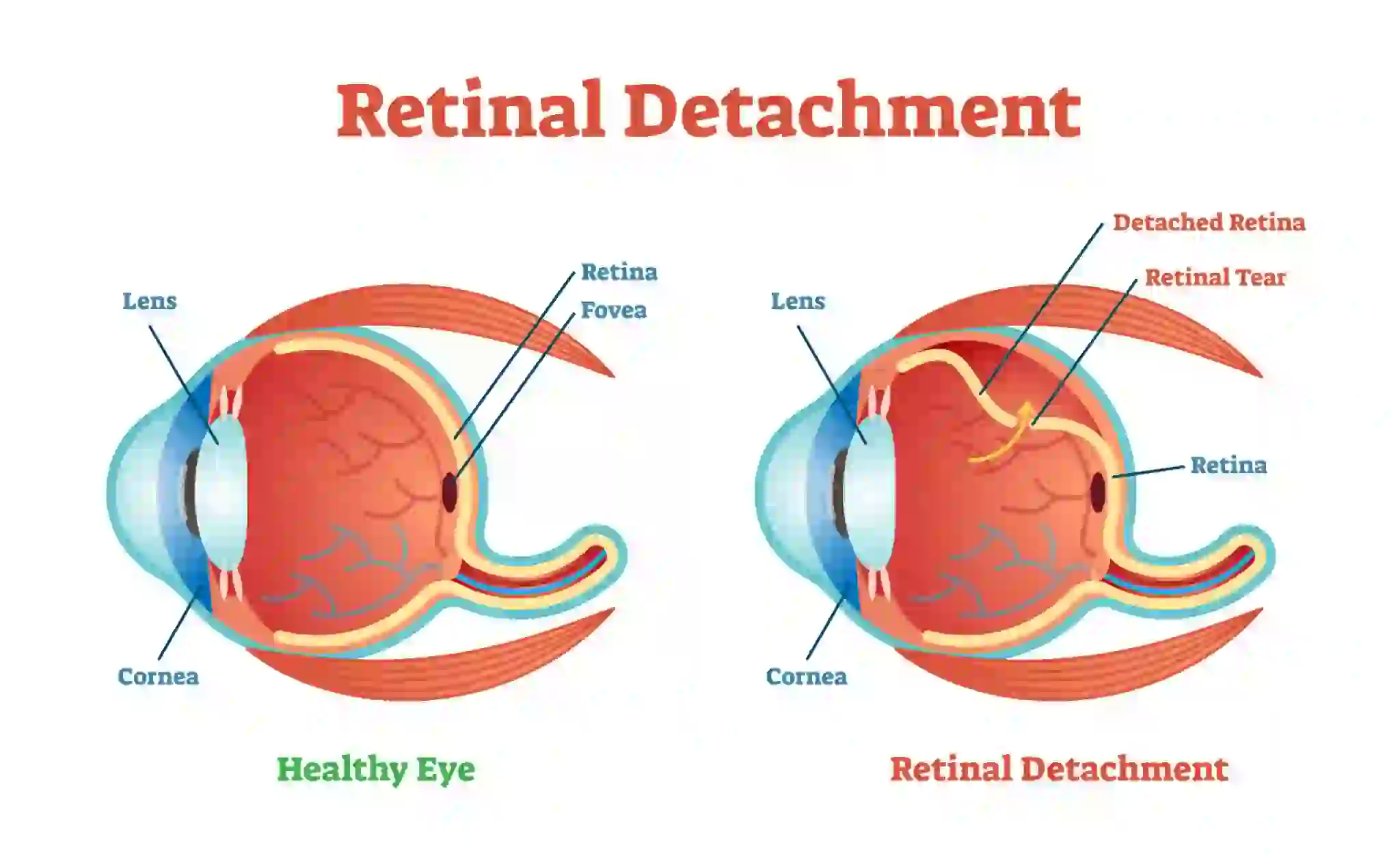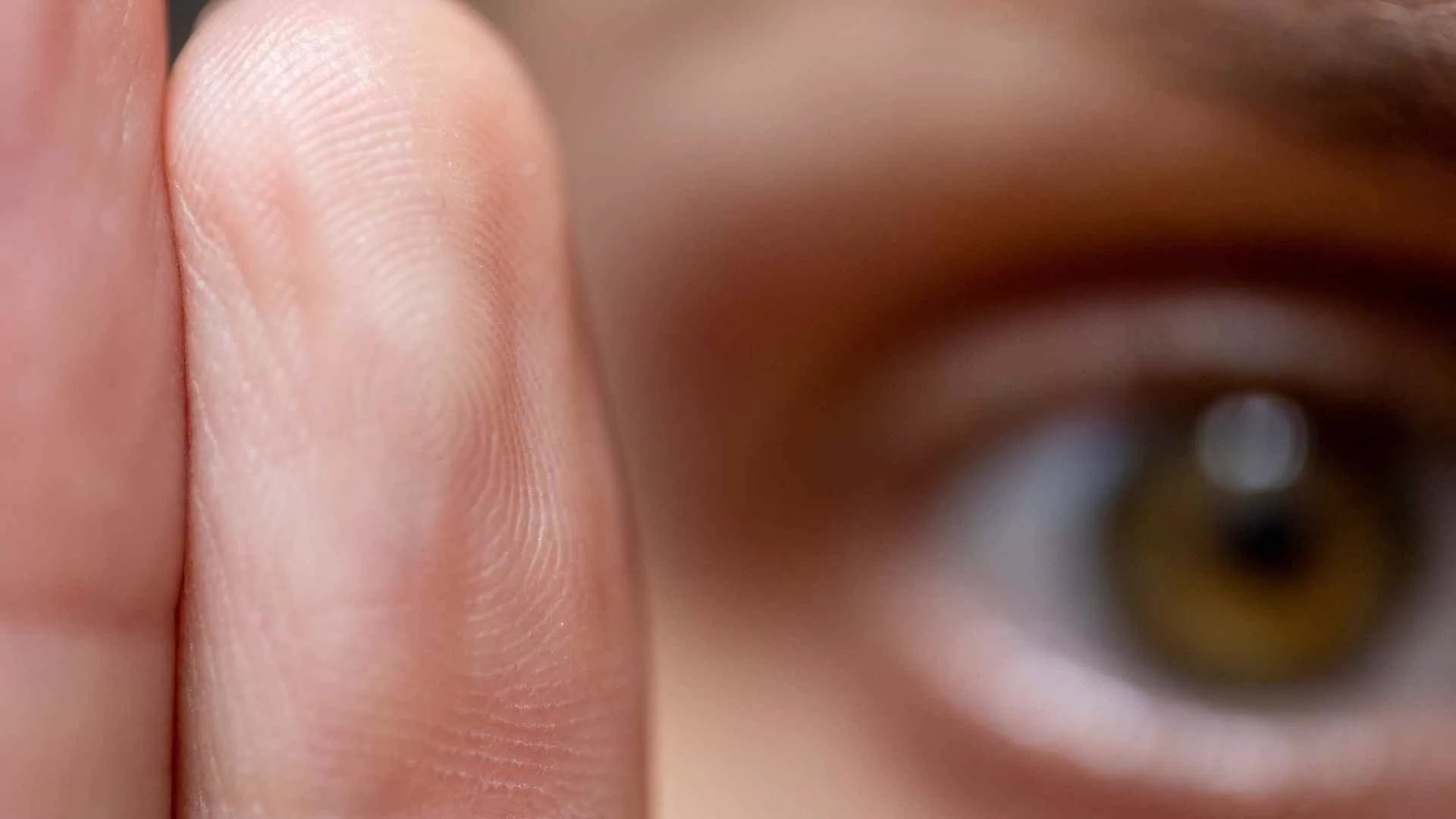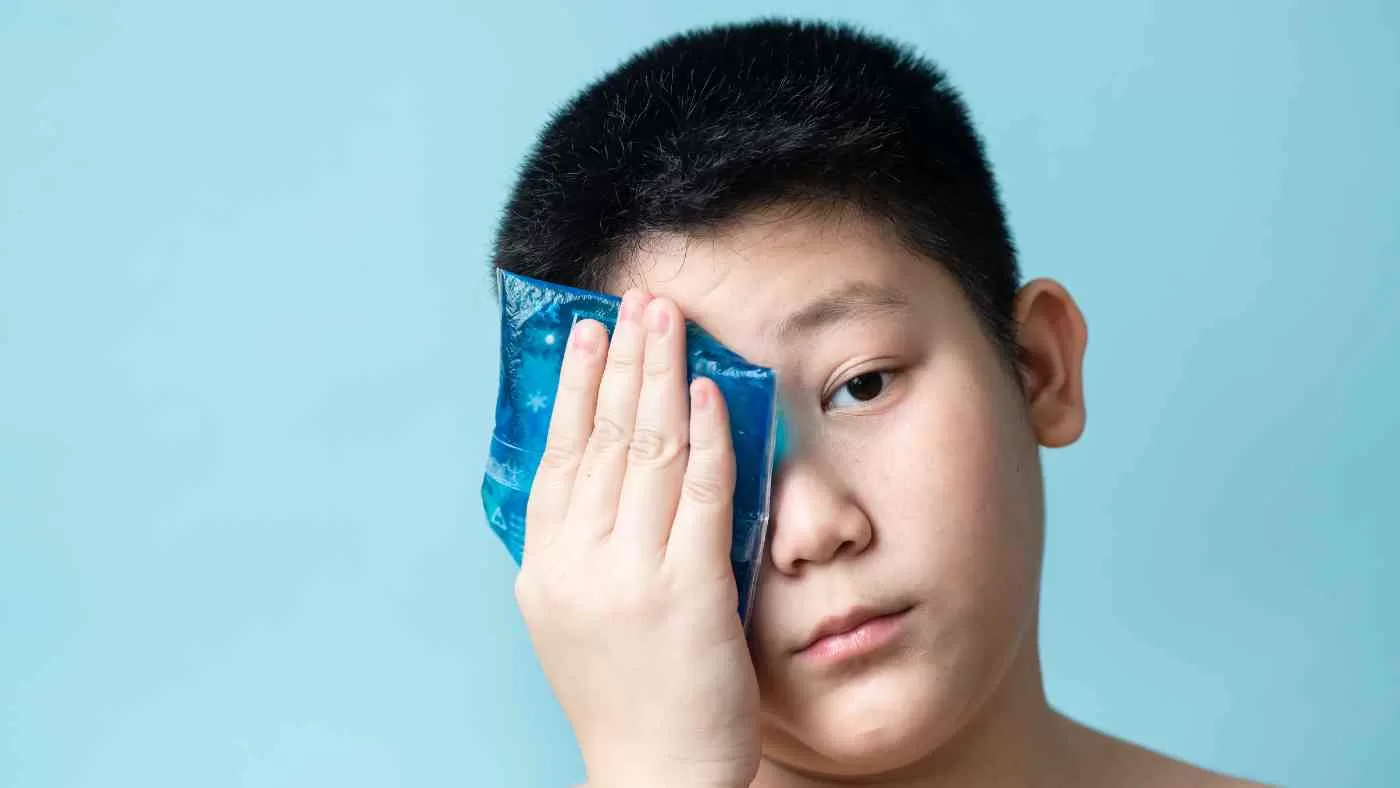 February 24, 2025
February 24, 2025
Understanding Diabetic Retinopathy: A Silent Threat to Vision
Diabetic retinopathy is a serious complication of diabetes that affects the eyes. It is a leading cause of blindness worldwide, particularly among working-age adults. Despite its severity, many individuals remain unaware of the progressive damage it can cause until significant vision loss occurs. Early detection and timely treatment are crucial in preventing irreversible blindness.
What Is Diabetic Retinopathy?
Diabetic retinopathy (DR) is a microvascular disorder that results from prolonged hyperglycemia, leading to damage of the retinal blood vessels. The retina, a light-sensitive layer at the back of the eye, relies on a network of tiny blood vessels to function correctly. High blood sugar levels compromise these vessels, causing leakage, occlusion, and abnormal vessel growth, all of which can impair vision.
Stages of Diabetic Retinopathy
Diabetic retinopathy progresses through distinct stages:
- Non-Proliferative Diabetic Retinopathy (NPDR): The early stage characterized by microaneurysms, retinal hemorrhages, and cotton wool spots. At this stage, vision may remain unaffected, but the disease continues to progress.
- Proliferative Diabetic Retinopathy (PDR): In advanced cases, ischemia (restricted blood flow) leads to neovascularization—abnormal blood vessel growth on the retina. These fragile vessels are prone to rupture, causing vitreous hemorrhage and tractional retinal detachment, which can lead to blindness.
- Diabetic Macular Edema (DME): Can occur at any stage of DR and is caused by fluid accumulation in the macula, the central part of the retina responsible for sharp vision. This results in blurred and distorted vision, significantly affecting daily activities like reading and driving.
Risk Factors
Several factors increase the likelihood of developing diabetic retinopathy, including:
- Poorly controlled blood sugar levels
- Hypertension (high blood pressure)
- Dyslipidemia (abnormal cholesterol levels)
- Duration of diabetes (longer disease duration increases risk)
- Smoking
- Pregnancy (in women with preexisting diabetes)
Symptoms and Diagnosis
Diabetic retinopathy is often asymptomatic in the early stages. As the disease progresses, symptoms may include:
- Blurred or fluctuating vision
- Dark spots or floaters
- Difficulty seeing at night
- Sudden vision loss
Diagnosis is made through comprehensive eye exams, including:
- Dilated Fundus Examination: To assess retinal abnormalities
- Optical Coherence Tomography (OCT): To evaluate retinal thickness and fluid accumulation
- Fluorescein Angiography: To identify areas of leakage and neovascularization
Treatment Options
Effective management of diabetic retinopathy depends on the stage and severity of the disease. Treatment options include:
- Blood Sugar and Blood Pressure Control: Tight glycemic and hypertensive control can slow disease progression.
- Laser Photocoagulation: A well-established treatment that seals leaking blood vessels and prevents further neovascularization.
- Intravitreal Injections: Anti-VEGF (vascular endothelial growth factor) injections, such as Ranibizumab, Aflibercept, and Bevacizumab, are commonly used to reduce macular edema and prevent further vessel growth.
- Vitrectomy: A surgical procedure for advanced cases involving vitreous hemorrhage or tractional retinal detachment.
Prevention and Regular Screening
The best approach to diabetic retinopathy is prevention through consistent diabetes management. Patients with diabetes should undergo annual dilated eye examinations to detect early changes. Lifestyle modifications, including a healthy diet, regular exercise, and smoking cessation, also play a significant role in reducing the risk of severe complications.
Conclusion
Diabetic retinopathy is a preventable cause of blindness, yet it remains a significant global health concern. With early diagnosis, appropriate interventions, and optimal diabetes management, individuals can preserve their vision and maintain a good quality of life. Regular screenings and adherence to treatment plans are the key to combating this silent yet devastating condition.
 February 5, 2025
February 5, 2025
Clear Vision, Bright Future: The Importance of Pediatric Eye Care
As parents and educators, we do everything we can to ensure a child’s healthy development. However, one crucial aspect of their well-being is often overlooked—their vision. Good eyesight is essential for learning, social interaction, and overall growth. At Netradham, we specialize in pediatric vision care, ensuring that children receive timely diagnosis and treatment for any eye-related issues.
Understanding Refractive Errors in Children
Refractive errors are among the most common vision problems affecting children. These occur when the shape of the eye prevents light from focusing correctly on the retina, leading to blurry vision. Without correction, these errors can impact a child’s ability to learn and interact with their surroundings.
The Four Main Types of Refractive Errors:
- Myopia (Nearsightedness): Difficulty seeing distant objects clearly. Caused by an elongated eyeball.
- Hyperopia (Farsightedness): Difficulty seeing nearby objects clearly. Caused by a shorter-than-normal eyeball.
- Presbyopia: An age-related difficulty in seeing up close due to changes in the lens.
- Astigmatism: Blurred vision at all distances caused by an irregularly shaped cornea.
Common Symptoms in Children
Children often do not recognize or report vision problems, making it crucial for parents and teachers to observe their behavior. Signs to watch for include:
- Sitting too close to the television or holding books and phones very near to their eyes.
- Frequent squinting or rubbing of the eyes.
- Complaints of headaches or eye strain, especially after reading or screen time.
- Difficulty concentrating in class, making mistakes while copying from the board.
- Double or hazy vision.
- Sensitivity to light or excessive tearing.
- Avoiding reading or other close-up tasks due to discomfort.
Importance of Regular Eye Check-Ups
Regular eye exams play a crucial role in detecting and correcting vision problems at an early stage. It is recommended that:
- The first eye check-up should be conducted before school admission, around the age of 3 years.
- Annual eye check-ups should be done for all children to monitor any changes in vision.
- Children who wear glasses should have an eye exam every six months to ensure their prescription remains accurate.
Consequences of Untreated Refractive Errors
If left uncorrected, refractive errors can lead to serious complications such as:
- Squinting of eyes (Strabismus): Misalignment of the eyes.
- Lazy eye (Amblyopia): Permanent vision impairment in one eye due to lack of proper visual development.
- Delayed learning and poor academic performance: Blurry vision can prevent children from excelling in school.
- Social and behavioral issues: Children with uncorrected vision problems may become withdrawn or develop anxiety related to their academic struggles.
Diagnosis and Treatment
Early detection through a simple vision test can prevent long-term issues. Treatment options include:
- Prescription Glasses: The most common and effective correction method.
- Contact Lenses: Suitable for older children and teenagers.
- Laser Eye Surgery: A permanent correction option for adults.
Regular eye exams are recommended for children, even if they do not exhibit symptoms, as vision changes can be subtle and progressive.
The Role of Parents and Teachers
A child’s vision directly impacts their academic performance and self-confidence. Teachers should monitor students for signs of vision issues and inform parents if they notice any concerns. Parents, in turn, should schedule regular eye check-ups, even if their child doesn’t exhibit symptoms.
Encouraging good eye health habits, such as limiting screen time, ensuring adequate lighting while reading, and promoting outdoor activities, can also help maintain healthy vision.
Netradham: Your Partner in Pediatric Eye Care
At Netradham, we recognize, diagnose, and treat vision problems in children to ensure they have a clear path to a brighter future. With our expert team, we provide comprehensive eye exams and personalized treatment plans to safeguard your child’s vision. Our commitment to pediatric vision care ensures that every child receives the necessary attention and treatment to see the world clearly.
Schedule a Pediatric Eye Check-Up Today!
A simple eye exam can make a world of difference. Book an appointment with Netradham today and take the first step toward protecting your child’s vision!
 February 3, 2025
February 3, 2025
Retinal Detachment: Causes, Symptoms, Care, Remedies, and Treatment
Introduction
Retinal detachment is a serious eye condition that occurs when the retina, the thin layer of tissue at the back of the eye, pulls away from its normal position. If left untreated, it can lead to permanent vision loss. Understanding the causes, symptoms, care, and treatment options is crucial for timely intervention and prevention of severe complications.
Understanding the Retina
The retina is a light-sensitive layer of tissue responsible for capturing images and sending signals to the brain via the optic nerve. When it detaches from the underlying layers of the eye, it loses its ability to function properly, leading to partial or complete vision loss.
Causes of Retinal Detachment
There are three primary types of retinal detachment, each caused by different factors:
- Rhegmatogenous Retinal Detachment:
- Caused by a tear or hole in the retina that allows fluid to seep underneath and separate it from the underlying tissue.
- Common risk factors include aging, severe nearsightedness (myopia), eye trauma, or previous eye surgery.
- Tractional Retinal Detachment:
- Occurs when scar tissue on the retina contracts and pulls it away from the back of the eye.
- Often seen in people with diabetes-related eye diseases, such as diabetic retinopathy.
- Exudative (Serous) Retinal Detachment:
- Results from fluid accumulation under the retina without any tears or holes.
- Can be caused by inflammatory diseases, tumors, or age-related macular degeneration.
Symptoms of Retinal Detachment
Retinal detachment is usually painless, but the symptoms can be alarming. Warning signs include:
- Sudden appearance of floaters (tiny specks or cobweb-like shapes drifting in vision)
- Flashes of light in one or both eyes
- Blurred vision or a sudden decrease in vision
- A shadow or curtain effect over part of the visual field
- Loss of peripheral (side) vision
Emergency Care and First Response
Retinal detachment is a medical emergency that requires immediate attention. If you experience any of the symptoms mentioned above, follow these steps:
- Seek Medical Help: Visit an ophthalmologist or emergency eye clinic without delay.
- Avoid Sudden Head Movements: Keep your head stable to prevent further detachment.
- Avoid Strenuous Activities: Do not engage in heavy lifting or physical exertion until assessed by a doctor.
Diagnosis of Retinal Detachment
An eye specialist will perform the following tests to diagnose retinal detachment:
- Dilated Eye Exam: Uses special eye drops to widen the pupil and examine the retina with a bright light.
- Ultrasound Imaging: If the retina cannot be clearly seen, ultrasound helps detect detachment.
- Optical Coherence Tomography (OCT): Provides a detailed cross-sectional image of the retina.
Treatment Options
Treatment for retinal detachment depends on its severity and cause. Some of the most common procedures include:
1. Laser Surgery (Photocoagulation)
- Uses a laser to seal a retinal tear before it leads to detachment.
- Effective for small or early-stage tears.
2. Cryopexy (Freezing Treatment)
- Involves freezing the area around a retinal tear to create scar tissue that helps reattach the retina.
- Often used in conjunction with other treatments.
3. Pneumatic Retinopexy
- A gas bubble is injected into the eye to push the detached retina back into place.
- The patient must maintain a specific head position to keep the bubble in place while the retina heals.
4. Scleral Buckling Surgery
- A silicone band is placed around the eye to gently push the detached retina back.
- Often used for more severe cases of detachment.
5. Vitrectomy
- A surgical procedure that removes the vitreous gel from the eye and replaces it with gas, air, or silicone oil to help the retina reattach.
- Used for complex cases, such as tractional detachment or severe retinal tears.
Post-Treatment Care and Recovery
After undergoing retinal detachment treatment, proper care is crucial for recovery:
- Follow your doctor’s instructions carefully.
- Avoid strenuous activities that may put pressure on the eyes.
- Use prescribed eye drops to prevent infection and inflammation.
- Maintain proper head positioning (if a gas bubble was used) to facilitate healing.
- Attend follow-up appointments to monitor healing and ensure the retina stays attached.
Preventive Measures and Remedies
While not all cases of retinal detachment can be prevented, certain lifestyle choices can reduce the risk:
- Regular Eye Check-ups: Early detection of retinal tears can prevent detachment.
- Manage Underlying Health Conditions: Control diabetes and high blood pressure to reduce eye complications.
- Protect Your Eyes from Trauma: Wear protective eyewear during sports or risky activities.
- Avoid Sudden Head Movements: Particularly if you have a high risk of retinal detachment.
- Be Aware of Symptoms: Recognizing early signs can lead to timely medical intervention.
Conclusion
Retinal detachment is a serious condition that requires immediate medical attention. Understanding its causes, symptoms, and treatment options can help individuals take proactive steps to protect their vision. Regular eye check-ups, maintaining a healthy lifestyle, and seeking timely medical care can significantly improve the chances of preserving sight and preventing complications.
 February 2, 2025
February 2, 2025
Understanding Eye Floaters: Symptoms, Causes, and When to See a Doctor
Eye floaters are a common visual phenomenon that can appear as tiny specks, threads, or cobweb-like shapes drifting across your field of vision. While they are usually harmless, eye floaters can sometimes indicate underlying eye conditions. In this article, we’ll delve into what causes eye floaters, their symptoms, and when to seek professional medical advice.
What Are Eye Floaters?
Eye floaters are small clumps of cells or protein fibers within the vitreous, the gel-like substance that fills the inside of the eye. These clumps cast shadows on the retina, the light-sensitive layer at the back of the eye, resulting in the appearance of floaters.
Most floaters are more noticeable when looking at a plain, bright background, such as a clear sky or a blank wall. While they may be distracting, they typically move out of your direct line of sight and do not pose a significant issue for vision.
Common symptoms include:
- Spots or strings in your vision that move as your eyes move.
- Shadows that seem to float away when you try to focus on them.
- Small shapes that appear to drift when you shift your gaze.
Floaters are usually most prominent under bright lighting conditions and may diminish or become less noticeable over time.
What Causes Eye Floaters?
Eye floaters often occur as a natural part of aging. The vitreous becomes more liquid over time, leading to microscopic fibers clumping together. These clumps cast shadows on the retina, creating floaters.
Other causes include:
- Posterior Vitreous Detachment (PVD): This occurs when the vitreous gel pulls away from the retina, often due to age.
- Inflammation (Uveitis): Inflammation in the layers of the uvea can cause floaters.
- Bleeding in the Eye: Blood cells released into the vitreous due to injury, diabetes, or hypertension can appear as floaters.
- Retinal Tears or Detachment: In rare cases, floaters may signal a retinal tear or detachment, which requires immediate attention.
- Eye Trauma or Surgery: Physical damage or procedures affecting the eye can lead to floaters.
When to See a Doctor
While most eye floaters are harmless, certain situations warrant a visit to an eye specialist:
- A sudden increase in the number of floaters.
- Flashing lights in your vision.
- Loss of peripheral or central vision.
- Changes in floaters following eye injury or surgery.
These symptoms could indicate a retinal tear, detachment, or other serious eye conditions requiring prompt medical attention.
Diagnosis and Treatment
An ophthalmologist can diagnose the cause of eye floaters using a comprehensive eye exam. They may dilate your pupils to examine the retina and vitreous more closely.
In most cases, treatment isn’t necessary as floaters often fade or become less noticeable. However, for severe cases affecting vision, treatment options include:
- Vitrectomy: A surgical procedure to remove the vitreous and replace it with a saline solution.
- Laser Therapy: Laser treatment to break up floaters into smaller, less noticeable pieces.
Both options carry risks and are generally reserved for extreme cases.
Preventing Eye Floaters
While floaters are often unavoidable, maintaining overall eye health can help reduce the risk of complications:
- Schedule regular eye exams.
- Manage chronic conditions like diabetes and hypertension.
- Protect your eyes from injury with proper safety gear.
- Maintain a healthy diet rich in vitamins A, C, and E.
Conclusion
Eye floaters are usually a natural result of aging, but sudden changes or additional symptoms like flashing lights and vision loss could signal a more serious condition. If you notice any concerning signs, don’t hesitate to consult an eye specialist. Staying proactive about your eye health is the best way to ensure clear vision for years to come.
 January 7, 2024
January 7, 2024
Unlocking the Potential of Vision Therapy: A Comprehensive Guide
Introduction
Welcome to a transformative journey towards enhanced visual health! At Netradham Eye Hospital, we understand the crucial role vision plays in our daily lives. In this comprehensive guide, we delve into the wonders of vision therapy, exploring its benefits and why it stands out as a game-changer in the realm of eye care.
Understanding Vision Therapy
What is Vision Therapy?
Vision therapy is a specialized form of eye care that goes beyond traditional methods. Unlike regular eye exams, vision therapy is a personalized, targeted approach to improve visual skills and processing. It addresses a myriad of issues, from eye strain, difficulties in reading and focusing to deviated eyes.
The Science Behind Vision Therapy
Vision therapy operates on the principle of neuroplasticity. This means that the brain has the ability to adapt and reorganize itself, making it a powerful tool for improving vision. Through a series of customized exercises and activities, vision therapy strengthens the connection between the eyes and the brain, fostering improved visual function.
Conditions Benefiting from Vision Therapy
Amblyopia (Lazy Eye)
Amblyopia, commonly known as lazy eye, is a condition where one eye has weaker vision than the other. Vision therapy has shown remarkable success in treating amblyopia by encouraging the brain to recognize and use signals from the weaker eye.
Convergence Insufficiency
Convergence insufficiency occurs when the eyes struggle to work together at close distances. Vision therapy focuses on enhancing eye coordination, enabling a smoother and more efficient convergence of the eyes.
Non Strabismic and Strabismic Binocular Vision Dysfunction
Binocular vision dysfunction is a condition, either with or without deviation of the eyes, Â where the eyes struggle to team together effectively . Vision therapy’s specialized exercises help improve binocular vision, reducing discomfort and enhancing overall visual clarity.
Benefits of Vision Therapy
Enhanced Academic Performance
Vision therapy isn’t just about treating vision problems; it’s about unlocking potential. Many individuals, especially children, experience significant improvements in academic performance after undergoing vision therapy. Improved visual skills directly contribute to better reading and comprehension.
Reduced Eye Strain and Fatigue
In today’s digital age, prolonged screen time has become inevitable. Vision therapy equips individuals with the tools to combat eye strain and fatigue, promoting overall eye comfort in an increasingly digital world.
Increased Sports Performance
Athletes rely heavily on their vision, and any improvement can have a profound impact on their performance. Vision therapy enhances visual tracking, depth perception, and overall eye-hand coordination, giving athletes a competitive edge.
The Vision Therapy Experience at Netradham Eye Hospital
Personalized Assessments
Our journey with you begins with a thorough assessment of your visual health. Our experienced optometrists at Netradham Eye Hospital will identify specific areas that may benefit from vision therapy, tailoring the program to your unique needs.
Targeted Exercises
No two individuals are alike, and neither are their vision issues. Our vision therapy programs at Netradham Eye Hospital consist of customized exercises designed to address your specific challenges through various computer based softwares. These exercises are conducted under the guidance of our expert therapists.
Progressive Monitoring
At Netradham Eye Hospital, we believe in tracking progress meticulously. Regular check-ups ensure that the prescribed vision therapy is yielding the desired results. Adjustments are made as needed to ensure continuous improvement.
Conclusion
Embark on a journey towards clearer, more efficient vision with vision therapy at Netradham Eye Hospital. Our commitment to excellence, personalized approach, and proven results set us apart in the realm of eye care.
 June 15, 2023
June 15, 2023
10 Tips for Choosing the Right Eye Care Professional in Nepal
Introduction:
In Nepal, where access to quality eye care is paramount, it’s important to consider certain factors when choosing the right eye care professional. In this article, we will provide ten tips to help you make an informed decision and find the best eye care professional in Nepal.
1. Check Credentials and Qualifications
When choosing an eye care professional, it’s essential to verify their credentials and qualifications. Look for professionals who are licensed and registered with relevant authorities in Nepal, such as the Nepal Medical Council. Ensure that they have the necessary certifications and qualifications to provide comprehensive eye care services.
2. Consider Specializations
Different eye care professionals may specialize in specific areas of eye care. Depending on your specific needs, consider seeking professionals who specialize in areas such as refractive surgery, pediatric eye care, or retinal diseases. Assessing their expertise and specialization can ensure that you receive the most appropriate and effective care for your specific condition.
3. Seek Recommendations
Word-of-mouth recommendations from friends, family, or trusted individuals can be invaluable in finding a reputable eye care professional. Ask for recommendations from people who have had positive experiences with eye care providers in Nepal. Their firsthand experiences and insights can help you make an informed decision.
4. Research the Facility and Equipment
Ensure that the eye care facility you choose is well-equipped with modern technology and instruments necessary for accurate diagnosis and treatment. Advanced equipment, such as digital imaging systems and laser technology, can enhance the quality of care. Research the facility’s reputation and commitment to maintaining high standards of hygiene and safety.
5. Evaluate Experience and Track Record
Consider the experience and track record of the eye care professional you are considering. Find out how long they have been practicing in the field and their success rates in treating various eye conditions. An experienced professional with a proven track record is more likely to provide high-quality care and better outcomes for patients.
6. Assess Communication and Patient-Centered Approach
Effective communication between you and your eye care professional is crucial for proper diagnosis and treatment. Look for professionals who are attentive, patient-centered, and take the time to listen to your concerns. They should be able to explain complex concepts in a way that you can understand, ensuring that you are well-informed and involved in your eye care journey.
7. Consider Accessibility and Location
Accessibility and location are important factors, especially for individuals living in Nepal. Choose an eye care professional or facility that is easily accessible, considering factors such as proximity to your home or workplace and availability of public transportation. This ensures convenience and timely access to necessary eye care services.
8. Evaluate Cost and Insurance Coverage
Consider the cost of eye care services and whether they align with your budget. Inquire about payment options, including insurance coverage and the types of insurance accepted by the eye care professional or facility.
9. Read Patient Reviews and Testimonials
Read patient reviews and testimonials about the eye care professional or facility you are considering. Online platforms and websites can provide insights into the experiences of previous patients. Look for positive reviews and feedback that indicate the provider’s competence, professionalism, and patient satisfaction.
10. Trust Your Instincts
Ultimately, trust your instincts when choosing an eye care professional. If you feel comfortable, confident, and trust the professional’s expertise, it is more likely to be a good fit for your eye care needs. Building a trusting and positive relationship with your eye care professional is crucial for long-term eye health management.
 June 15, 2023
June 15, 2023
Eye Problems at Work: Essential Tips for Office Workers
Introduction:
As office workers, we spend a significant portion of our day in front of screens, which can take a toll on our eyes. Prolonged screen time, improper lighting, and poor ergonomics can lead to various eye problems and discomfort. However, with a few simple adjustments and mindful habits, you can protect and maintain good eye health while at work.
1. Set Up an Eye-Friendly Workspace
Creating an eye-friendly workspace is crucial for minimizing eye strain and discomfort. Position your computer screen at eye level, about an arm’s length away, to reduce the need for excessive eye movement and maintain a comfortable viewing distance. Adjust the screen brightness and contrast to a level that is easy on your eyes, and ensure that the ambient lighting in your workspace is neither too dim nor too bright.
2. Take Regular Screen Breaks
Staring at a screen for extended periods can cause digital eye strain. To alleviate this, practice the 20-20-20 rule: every 20 minutes, take a 20-second break and look at something 20 feet away. This helps relax the eye muscles and reduces the risk of eye fatigue. Additionally, make a conscious effort to blink frequently during screen time to keep your eyes moisturized and prevent dryness.
3. Adjust Screen Settings for Comfort
Adjusting your screen settings can significantly reduce eye strain. Increase the text size and adjust the font and contrast settings to make it easier to read without squinting. Consider using dark mode or adjusting the color temperature of your screen to minimize blue light exposure, which can cause eye fatigue and disrupt sleep patterns.
4. Optimize Lighting Conditions
Proper lighting is essential for a comfortable work environment. Avoid glare by positioning your computer screen perpendicular to any windows or light sources. If necessary, use an anti-glare screen filter to minimize reflections. Ensure that the overall lighting in your workspace is adequate, neither too dim nor too bright, to prevent eye strain and discomfort.
5. Practice Proper Ergonomics
Maintaining proper ergonomics is not only beneficial for your overall well-being but also for your eye health. Position your chair and desk in a way that allows for a comfortable and natural viewing angle. Adjust the height of your chair to ensure that your feet are flat on the floor and your arms are at a 90-degree angle when typing. This helps prevent neck and shoulder strain, which can indirectly impact your eye comfort.
6. Stay Hydrated
Proper hydration is essential for maintaining good eye health. Drink an adequate amount of water throughout the day to prevent dry eyes. Dehydration can contribute to eye dryness and irritation, so keep a water bottle handy and make it a habit to stay hydrated.
7. Use Artificial Tears
If you experience dryness or eye irritation, consider using artificial tears or lubricating eye drops. These can provide temporary relief by moisturizing your eyes and alleviating discomfort. Choose preservative-free drops and follow the recommended dosage and application instructions.
8. Keep Your Work Area Clean
Maintaining a clean work area helps prevent the accumulation of dust, which can contribute to eye irritation and allergies. Regularly clean your computer screen, keyboard, and desk surface to minimize the presence of allergens and irritants that can affect your eyes.
9. Get Regular Eye Examinations
Regular eye examinations are crucial for detecting and managing eye problems early on. Schedule comprehensive eye exams with an optometrist or ophthalmologist at recommended intervals. They can assess your eye health, detect any underlying issues, and provide appropriate recommendations or corrective measures.
 June 15, 2023
June 15, 2023
5 DIY Remedies for Soothing Eye Problems at Home
Introduction:
Eye problems can be uncomfortable and disrupt our daily lives. Whether it’s dryness, redness, or irritation, finding relief for these issues is essential. While it’s always advisable to consult with an eye care professional for severe or persistent problems, there are several do-it-yourself (DIY) remedies that can provide soothing relief at home.
1. Warm Compresses: A Natural Soother
Warm compresses can provide immediate relief for various eye problems, including dry eyes, styes, and mild eye irritation.
Procedure:
Soak a clean cloth in warm water and wring out the excess. Close your eyes and place the warm compress gently over your eyelids for 5 to 10 minutes. The warmth helps increase blood circulation, soothes the eyes, and promotes tear production, providing relief and comfort.
2. Cucumber Slices: Cooling and Refreshing
Cucumber slices are not just for spa treatments; they can also help soothe tired and puffy eyes. The cool temperature and high water content of cucumbers have a refreshing effect on the eyes, reducing puffiness and inflammation.
Procedure:
Slice a chilled cucumber and place the slices over your closed eyelids for 10 to 15 minutes. Allow the cucumber’s natural properties to work their magic, leaving your eyes feeling rejuvenated and revitalized.
3. Cold Water Eye Rinse: Quick Relief for Irritation
If you’re experiencing eye redness, itching, or general irritation, a cold water eye rinse can provide quick relief.
Procedure:
Simply splash cold water onto your closed eyes, or use a clean cup or your hands to pour cold water over your eyes. This helps wash away any irritants and soothes the eyes. Make sure the water is cold but not freezing to avoid any discomfort. Repeat the process as needed to alleviate the symptoms.
4. Chamomile Tea Bags: Nature’s Calming Agent
Chamomile tea bags have natural anti-inflammatory and soothing properties that can benefit your eyes.
Procedure:
Brew a cup of chamomile tea using two tea bags and let them cool down. Once cool, squeeze out the excess liquid from the tea bags and place them on your closed eyelids for 10 to 15 minutes. The chamomile’s gentle properties will help reduce inflammation, relieve eye redness, and promote relaxation.
5. Eye Massage: Gentle Touch for Relaxation
Massaging the area around your eyes can help alleviate tension and promote relaxation.
Procedure:
Start by washing your hands thoroughly, then use your fingertips to apply gentle pressure around your closed eyes. Using circular motions, massage the temples, eyebrows, and the area between your eyebrows. This helps stimulate blood circulation, relieve eye strain, and reduce puffiness. Perform this gentle eye massage for a few minutes whenever you feel tension or fatigue in your eyes.
 June 15, 2023
June 15, 2023
Understanding the Causes of Eye Twitching
Introduction:
Eye twitching, also known as eyelid twitching or myokymia, is a common condition that can be quite bothersome. It is characterized by involuntary spasms or twitches of the eyelid muscles. In this article, we will explore the various factors that can contribute to eye twitching, helping you understand its causes and potential remedies.
1. Stress and Fatigue
One of the most common causes of eye twitching is stress and fatigue. When we experience high levels of stress or are sleep-deprived, our bodies may react with muscle contractions, including those in the eyelids. Managing stress through relaxation techniques, getting sufficient rest, and adopting healthy sleep habits can help alleviate eye twitching associated with these factors.
2. Eye Strain and Digital Eye Fatigue
Prolonged periods of focusing on digital screens, reading, or driving can strain the eye muscles, leading to eye fatigue and twitching. This is particularly common in the digital age when many people spend long hours in front of screens. Taking regular breaks, practicing the 20-20-20 rule (looking at something 20 feet away for 20 seconds every 20 minutes), and ensuring proper lighting and ergonomics can help reduce eye strain and minimize eye twitching.
3. Caffeine and Alcohol Consumption
Excessive consumption of caffeine or alcohol can contribute to eye twitching. Both substances can interfere with the normal functioning of the nervous system, leading to muscle spasms, including those in the eyelids. Moderating your caffeine and alcohol intake or avoiding them altogether may help reduce the occurrence of eye twitching.
4. Dry Eyes
Dry eyes occur when the eyes do not produce enough tears or the tears evaporate too quickly, resulting in dryness, irritation, and potential eye twitching. Factors such as environmental conditions, extended screen time, certain medications, and underlying medical conditions can contribute to dry eyes. Using artificial tears, taking regular breaks to rest your eyes, and ensuring proper humidity in your environment can help reduce eye twitching associated with dry eyes.
5. Nutritional Deficiencies
In some cases, nutritional deficiencies, such as insufficient magnesium or potassium levels, can contribute to eye twitching. These minerals play important roles in muscle function and nerve conduction. Maintaining a balanced diet rich in fruits, vegetables, and whole grains can help ensure adequate nutrient intake and reduce the likelihood of eye twitching due to deficiencies.
6. Allergies and Eye Irritation
Allergies and eye irritation caused by allergens, such as pollen or dust, can trigger eye twitching in some individuals. The release of histamines in response to allergens can lead to inflammation and muscle spasms, including those in the eyelids. Managing allergies through avoidance of triggers, using allergy medications as recommended by a healthcare professional, and maintaining a clean environment can help get rid of eye twitching associated with allergies.
7. Eye Infections or Eye Surface Conditions
Eye infections, such as pink eye (conjunctivitis), or certain eye surface conditions, like blepharitis or corneal abrasions, can cause eye twitching. These conditions result in inflammation and irritation of the eyes, leading to involuntary muscle contractions. Seeking prompt medical attention, following proper hygiene practices, and adhering to prescribed treatments can help prevent eye twitching caused by infections or surface conditions.
8. Underlying Medical Conditions
In rare instances, eye twitching can be a symptom of an underlying medical condition, such as facial nerve disorders (hemifacial spasm) or movement disorders (dystonia). If eye twitching persists or is accompanied by other concerning symptoms, it is advisable to consult a healthcare professional for a comprehensive evaluation and appropriate diagnosis.
 June 15, 2023
June 15, 2023
10 Surprising Causes of Eye Problems You Never Knew About
Introduction:
While we often associate eye problems with age-related conditions or genetic factors, there are several surprising causes that can affect our eye health. In this article, we will explore ten lesser-known causes of eye problems that you may not be aware of.
1. Digital Eye Strain: The Price of Technology
In our modern digital age, many of us spend long hours staring at screens, be it computers, smartphones, or tablets. This excessive screen time can lead to digital eye strain, characterized by symptoms such as dryness, blurred vision, and headaches. To prevent digital eye strain, it is crucial to take regular breaks, practice the 20-20-20 rule, and consider using blue light filters or glasses.
2. Smoking and Eye Health: A Risky Combination
Smoking is not only detrimental to our overall health but also has a profound impact on our eyes. It increases the risk of developing eye conditions such as cataracts, age-related macular degeneration (AMD), and dry eye syndrome. The harmful chemicals in tobacco smoke can damage the blood vessels in the eyes, leading to vision loss. Quitting smoking is a vital step toward preserving your eye health and reducing the risk of these conditions.
3. Indoor Air Pollution: Unseen Culprit for Eye Problems
We often associate air pollution with outdoor environments, but indoor air quality can also affect our eye health. Indoor pollutants such as dust, pet dander, and chemicals from cleaning products can cause eye irritation, redness, and allergies. Maintaining good indoor air quality, regularly cleaning your living spaces, and using air purifiers can significantly reduce the risk of eye problems associated with indoor air pollution.
4. Poor Nutrition: A Blind Spot for Eye Health
Deficiencies in essential nutrients like vitamin A, C, E, and omega-3 fatty acids can lead to vision problems. Incorporating a variety of fruits, vegetables, fish, nuts, and seeds into your diet can provide the necessary nutrients to support healthy eyes and reduce the risk of eye conditions such as dry eyes and age-related macular degeneration.
5. Hormonal Changes and Vision: Not Just a Women’s Issue
Hormonal fluctuations can impact the health of our eyes, and this is not limited to women alone. Conditions such as dry eyes, blurry vision, and light sensitivity can be influenced by hormonal changes during puberty, pregnancy, and menopause. Regular eye examinations, managing underlying health conditions, and using artificial tears or lubricating eye drops can help alleviate these symptoms and maintain optimal eye health.
6. Medications and Eye Side Effects: Unwanted Consequences
Certain medications that we take for other health conditions can have adverse effects on our eyes. Some drugs, like corticosteroids and antihistamines, can cause dry eyes and other vision-related issues. It is essential to be aware of the potential side effects of any medications you are taking and discuss any concerns with your healthcare provider. They may offer alternatives or suggest additional measures to protect your eyes.
7. Lack of Sleep: Tired Eyes, Blurry Vision
Sleep deprivation not only affects our energy levels and overall well-being but also takes a toll on our eye health. Insufficient sleep can lead to dry eyes, eye fatigue, and blurred vision. Getting an adequate amount of quality sleep each night is crucial for allowing your eyes to rest and regenerate. Establishing a regular sleep routine, creating a comfortable sleep environment, and practicing good sleep hygiene can help prevent eye problems associated with lack of sleep.
8. Allergies and Eye Health: A Sneezing Sight
Seasonal allergies, also known as hay fever, can wreak havoc on our eyes. The allergens in the air, such as pollen or dust mites, can cause redness, itching, and watering of the eyes. Taking antihistamines, using saline eye drops, and avoiding allergens whenever possible can provide relief and minimize the impact of allergies on your eye health.
9. Prolonged Sun Exposure: More Than Meets the Eye
We all know the importance of protecting our skin from the sun’s harmful rays, but we often overlook the impact of sun exposure on our eyes. Prolonged exposure to ultraviolet (UV) radiation can lead to cataracts, macular degeneration, and corneal sunburn. Wearing sunglasses with UV protection, a wide-brimmed hat, and avoiding direct sunlight during peak hours can safeguard your eyes from the damaging effects of the sun.
10. Stress and Eye Strain: An Unseen Burden
Chronic stress not only affects our mental and physical well-being but can also impact our eyes. Stress can cause eye strain, tension headaches, and even exacerbate existing eye conditions. Incorporating stress-reducing techniques such as meditation, exercise, and maintaining a healthy work-life balance can help alleviate the strain on your eyes and promote overall eye health.




